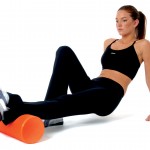If you work out regularly, have tight muscles, suffer from injuries, have muscle imbalances, feel stressed or experience tension in your body, then foam rolling is meant for you.
The foam roller not only stretches muscles and tendons, but it breaks down soft tissue adhesions and scar tissue. By using your own body weight and a cylindrical foam roller, you can perform a self-massage or myofascial release, break up trigger points and soothe tight fascia while increasing blood flow and circulation to the soft tissues. This can lead to improved range of motion, flexibility and movement and workouts, along with increased blood flow.
Myofascial release is a body-work technique in which you use gentle, sustained pressure on the soft tissues while applying traction to the fascia. This technique results in softening and lengthening (release) of the fascia and breaking down scar tissue or adhesions between skin, muscles and bones. Think of this like a massage. Myofascial release has also been shown to relieve various muscle and joint pains such as IT band syndrome and shin splints, and it also improves flexibility and range of motion.
Foam rollers, which are rollers shaped like pool noodles that are made from dense foam, are often used to help massage and stretch sore muscles, and are an inexpensive, at-home form of treatment. These rollers can vary in density and firmness and are a great way to intensify a regular workout, add stability during exercise and stretch out sore muscles.
There are all sorts of foam rollers available, with different sizes, firmness and color. What’s best for you depends on how often you’ll be using it and your level of experience. It can be painful at first, so I highly recommend a softer foam roller at the beginning.




